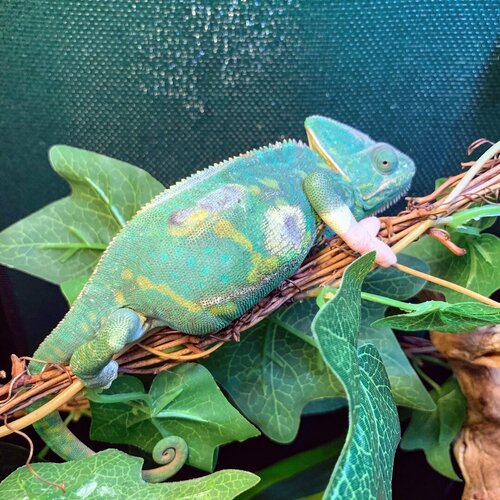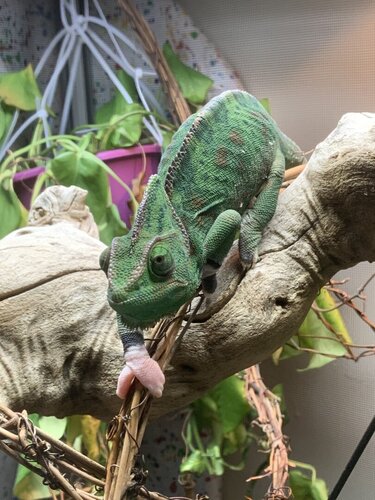JackRipper
Avid Member
I thought I was replying to a pm. I wouldn't mind further discussing this with you in private
Follow along with the video below to see how to install our site as a web app on your home screen.
Note: This feature may not be available in some browsers.
This is to hot this will cook a panther of this age . Please stop recommending in this post !!!!!!!!!!.Adult panther chameleons need a basking spot of around 100 degrees Fahrenheit with the ambient temperature between 75 to 85 degrees; smaller panther chameleons should have a basking area of 85 to 90 degrees with a lower ambient temperature of around 75 degrees. It is important for panther chameleons to thermoregulate. This is what you will find I've searched for recommendations on daytime lows and couldn't find any recommendations in the low 60s for Panthers of any local. These are Montain daytime temps and the OP stated that he spends almost all of the time in his one basking spot.. recommending a ambient tr
You're recommending an ambient daytime temp of 64° for a noseybe?
I have most of the recommendations from most available sources and they all vary but none recommend an ambient daytime temp of 60-65° as noseybe aren't a Montain species Our OP has stated that the cham is always or mostly at the basking area. That being said i know they are arborial animals but if under the heat source constantly he may feeling that 64° (64° with a basking area that's warmer is how I keep Jackson's ) this is where it may get confusing for a noseybee keeper.
That info was copied and pasted from another thread and is an example of how info compared toThis is to hot this will cook a panther of this age . Please stop recommending in this post !!!!!!!!!!.
That's great. Now that's how we work as a teamjust to add some proof.
Bottom of cage 63.4 f
View attachment 251554
Lennon in his favourite sleeping spot 12 inches off bottom of cage. About 70 f
View attachment 251555
Top of cage on plants. 75f
View attachment 251556
Baking spot about 85
View attachment 251557
Ambient AIR temp in the room
View attachment 251559
That in a cold climate is unnecessary/ harmful , likely further confusing op . I will not reply to anything you further quote me in to insure this thread stays on track . Best of luck to op .That info was copied and pasted from another thread and is an example of how info compared to
Baby/juvenile (<9 months): ambient 72-80F (22-26C), basking 82F (28C)
Adult males: ambient 75-80F (23-26C), basking 85-90F (29-32C)
Adult females: ambient 75-80F (23-26C), basking 80-85F (26-29C)-- varies from breeder to breeder. I think its important to explore all available information to find a middle ground for your specific requirements. The OP in this thread lives in a colder climate or has the A/C set to low so to make up for the lower ambient or room temp of 64° it may very well be necessary to up the wattage on the basking lite. If he lived in a hot arid climate he may not require a basking lamp altho I always recommend atleast the very minimum just incase. And if the minimum wattage is creating too much heat then direct the heat from top to the side of the cage or an alternate means of climate control may be required
That in a cold climate is unnecessary/ harmful , likely further confusing op . I will not reply to anything you further quote me in to insure this thread stays on track . Best of luck to op .
That info was copied and pasted from another thread and is an example of how info compared to
Baby/juvenile (<9 months): ambient 72-80F (22-26C), basking 82F (28C)
Adult males: ambient 75-80F (23-26C), basking 85-90F (29-32C)
Adult females: ambient 75-80F (23-26C), basking 80-85F (26-29C)-- varies from breeder to breeder. I think its important to explore all available information to find a middle ground for your specific requirements. The OP in this thread lives in a colder climate or has the A/C set to low so to make up for the lower ambient or room temp of 64° it may very well be necessary to up the wattage on the basking lite. If he lived in a hot arid climate he may not require a basking lamp altho I always recommend atleast the very minimum just incase. And if the minimum wattage is creating too much heat then direct the heat from top to the side of the cage or an alternate means of climate control may be required
I'm glad we bought it to light. There is so much misinformation out there I see it every day. I traced this info to a reptile magazine smh they were off by 5° which may not seem to be a big deal but .. it can be.so I just looked up the 2 other threads that those temps were mentioned in and if you would of read the next post in each of them they were basically the same as mine asking where you got that info from because it is wrong. This is why it is important to do research before giving people bad advice.
I'm glad we bought it to light. There is so much misinformation out there I see it every day. I traced this info to a reptile magazine smh they were off by 5° which may not seem to be a big deal but .. it can be.
Exactly. This is why you need to figure this stuff out before sharing it with someone looking for help because it can mean life or death to their chameleon.
The second file I shared was more accurate based on common husbandry. Question- in a large tall screen enclosure would a basking area of 100° at 8" away be safe? Maybe not recommended but safe if the bottom of the enclosure was in the lower 60s? And the middle in the 70s? Or is it always unsafe do to the screen heating up and burning the feet of a cham if climbing upside down? Cause that would make sense to me.
The second file I shared was more accurate based on common husbandry. Question- in a large tall screen enclosure would a basking area of 100° at 8" away be safe? Maybe not recommended but safe if the bottom of the enclosure was in the lower 60s? And the middle in the 70s? Or is it always unsafe do to the screen heating up and burning the feet of a cham if climbing upside down? Cause that would make sense to me.
I rehabbed a girl with such burns , the basking was no where close to 100f . It’s months of painful rehab .it’s not just a risk to burning their feet when climbing on the top screen. They can burn their spines and sides and head etc. They don’t know to move when they are to hot they will sit their with their mouth open venting hot air.
When you have a focused heat source in a reflected dome fixture it is pointing most of that heat straight down ontop of them. What ever you reading is on the basking branch it is hotter where the chameleon actualy sits an inch and half or so above that.
go stick you hand under a 100f light for 10 mins and see if it doesn’t burn your hand. We have seen way to many chameleons on here with sever burns and we don’t want to give advice that can lead to more.
This is what will happen if you allow a cham to 100+f tempsThe second file I shared was more accurate based on common husbandry. Question- in a large tall screen enclosure would a basking area of 100° at 8" away be safe? Maybe not recommended but safe if the bottom of the enclosure was in the lower 60s? And the middle in the 70s? Or is it always unsafe do to the screen heating up and burning the feet of a cham if climbing upside down? Cause that would make sense to me.


This is what will happen if you allow a cham to 100+f tempsView attachment 251563
she lost her back spikes because of the thermal burn
View attachment 251564
I didn’t do this to her I rehabbed her
I blame the mealworms she was feed previously lol that’s why she’s my fat cow. Learned a lot on how bad husbandry can effect a chameleon Through herthat poor girl. Looks like she never missed a meal either.
Poor sweet girl. I'm glad your spoiling her she looks happy.This is what will happen if you allow a cham to 100+f tempsView attachment 251563
she lost her back spikes because of the thermal burn
View attachment 251564
I didn’t do this to her I rehabbed her